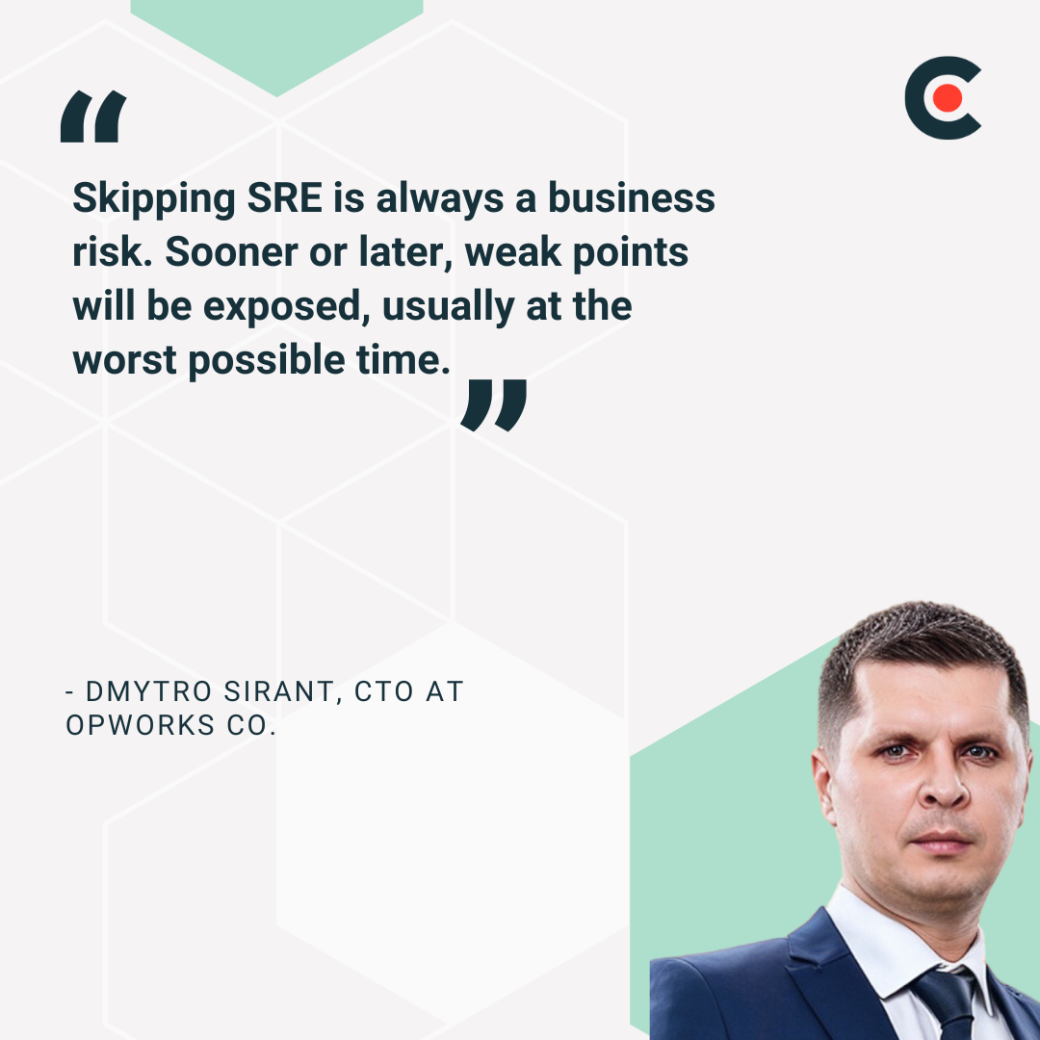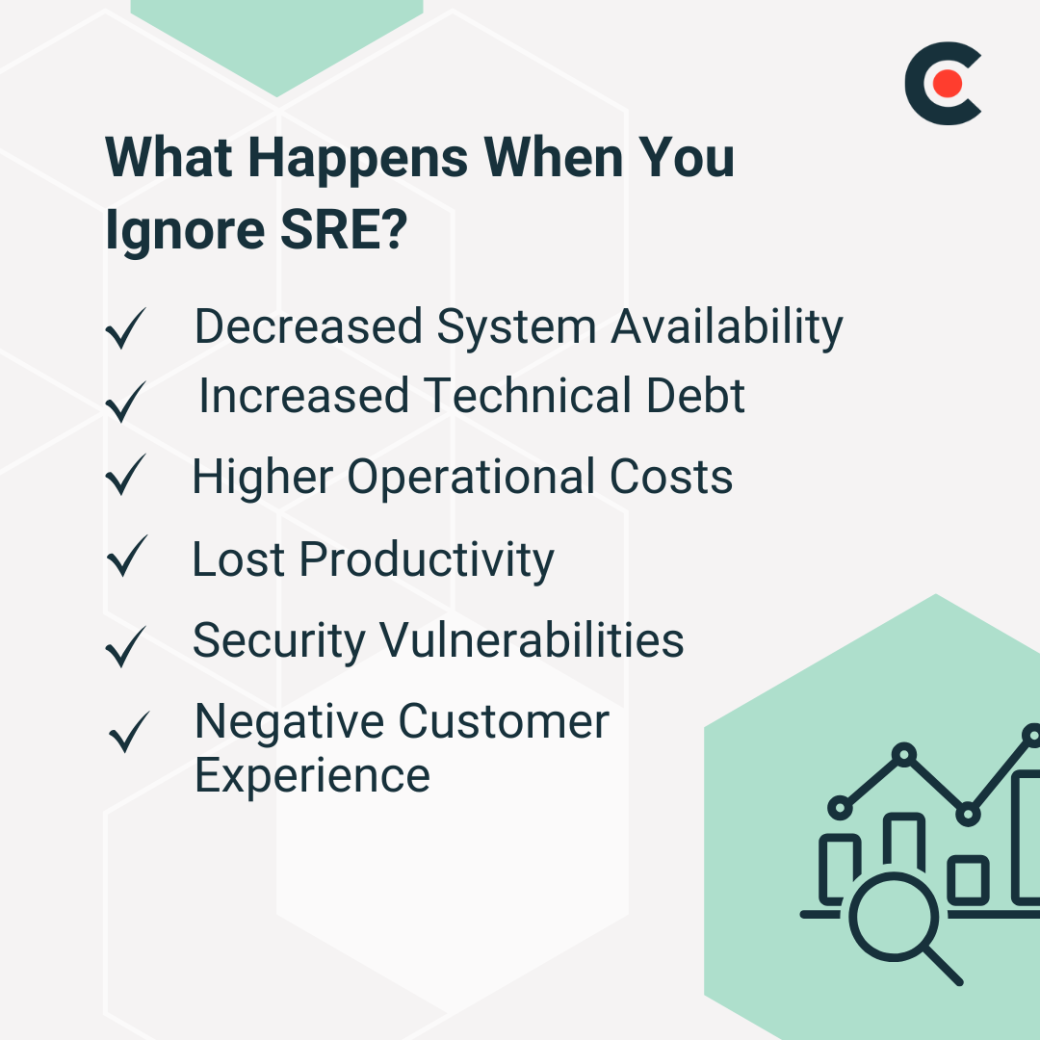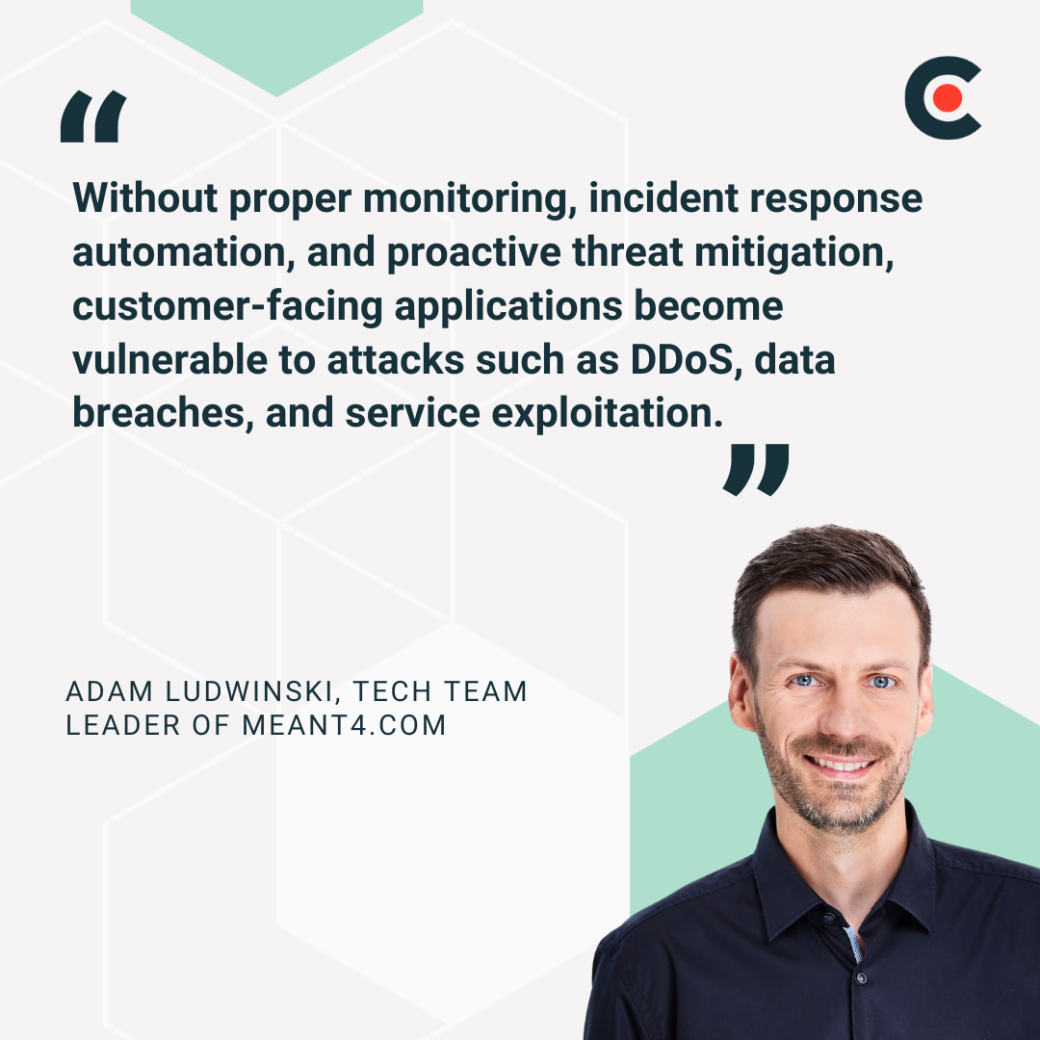

Updated March 19, 2025
In February 2025, the popular workplace app Slack experienced a mass outage. For hours, thousands of employees couldn’t send or receive messages. While some people celebrated the peace, others panicked — with one user even asking on X, “Is Slack down or did I get fired[?]”
Incidents like these highlight the importance of site reliability engineering (SRE). This field uses software engineering practices and tools to keep websites running smoothly. It has two main goals: keep sites available and help them bounce back quickly when issues occur.
Looking for a Software Development agency?
Compare our list of top Software Development companies near you
Having an SRE team in place can make a huge difference in site performance. But many businesses overlook this side of operations — often with expensive consequences. “Skipping SRE is always a business risk,” warns Dmytro Sirant, CTO at OpWorks. “Sooner or later, weak points will be exposed, usually at the worst possible time.”

This article reveals some of the hidden costs of overlooking site reliability engineering. We’ll also share expert tips for improving your website’s reliability so you can avoid the kind of meltdown Slack experienced.
Site reliability engineering focuses on keeping systems reliable — in other words, keeping them up and running smoothly. It uses various types of software to track performance and fix issues before they snowball into epic crashes. Think of it as a mixture of software engineering and systems operations, with a healthy dose of crisis management.
SRE is all about preparing for the unexpected. Users expect their applications to always be available — even when hardware fails or hackers attack the system. The stakes are especially high when customers rely on sites for critical tasks. If a hospital can’t access electronic records, for instance, patients might not get the treatment they need.
SRE involves several key practices:
You might wonder, “Don't traditional IT operations already cover all this?” Not quite. SRE goes the extra mile by participating in the development process. It uses coding to build reliable infrastructure and takes a proactive approach. By contrast, traditional IT focuses on reacting to issues as they occur.
People often assume that site reliability engineering is a luxury or something only huge enterprises need. But companies of all sizes need this approach. Not convinced yet? Here are a few potential consequences of not investing in SRE.

Increased downtime is one of the most obvious side effects of ignoring SRE. When you don’t protect your website’s reliability, it’s more likely to go down.
This could be caused by something as simple as forgetting to renew your SSL certification. Spikes in traffic — like during a sale or after your brand goes viral — can crash servers, too. And don’t forget about the ever-present threat of cyberattacks. By 2028, these incidents are expected to cost businesses a staggering $1.82 trillion annually.
Downtime can be incredibly annoying for customers. No one wants to be greeted with an error message when trying to use their favorite site. But outages are more than just an inconvenience. They also have significant consequences for your business, such as:
The infamous Delta Air Lines outage demonstrates everything that can go wrong. In 2024, the cybersecurity firm CrowdStrike allegedly failed to test a software update before rolling it out. Their faulty software triggered a global outage, forcing Delta to cancel over 7,000 flights. The result? Over $500 million in lost revenue and extra expenses, plus a serious blow to Delta’s reputation.
Sirant provided another cautionary tale about how neglecting SRE greatly impacted a major independent merchant service’s CRM: “Their system lacked proactive monitoring, automated failure recovery, and resilience strategies, leading to chronic outages, slow incident response, and a culture of reactive firefighting,” said Sirant. “So, with a strict Master Service Agreement in place, every hour of downtime cost them over $60,000. A few outages a year turned into a six-figure loss.”
The client decided to focus on SRE and took several steps, including:
Overlooking SRE doesn’t always lead to dramatic crashes. Sometimes, the effects build up slowly, gradually impacting your system’s performance.
This often occurs when businesses overlook a series of minor issues. Maybe your site has inefficient code that makes it a bit clunky or slows loading times. Or it might have glitches that only affect a handful of users. As your site grows, these problems become harder to ignore. Before you know it, you’ve got a buggy site that’s impossible to use.
Manual processes add technical debt, too. Does your IT team still manually monitor your system? They might miss vulnerabilities that monitoring software would catch in seconds. Or they could manually back up data and update software. If an employee goes on vacation or gets distracted, these vital processes may get skipped.
And don’t underestimate the impact of ad-hoc solutions. While quick fixes might make sense in the short term, they can bog down your system over time. A workaround here, a manual override there — it’s a recipe for inefficiency.
As this technical debt grows, you may struggle to scale your site. Sirant explains, “Neglecting SRE makes scaling inefficient, unpredictable, and ultimately unsustainable. I've seen companies try to scale by simply adding more servers, increasing cloud instances, or throwing money at infrastructure.”
While these workarounds may help temporarily, they don’t support long-term growth. “Sooner or later, the performance of their system degrades under load,” Sirant says. “All because of a lack of reliability, observability, and automated resilience.”
Meta’s Llama 3 405B training highlights the consequences of technical debt. Over 400 disruptions occurred during its training run, caused by everything from software bugs to memory failures. With proper maintenance and SRE practices, Meta could have avoided many of these issues.
Avoiding the expenses associated with hiring SRE specialists or pricey software may seem like an easy way to save money. But don’t be fooled. This approach comes with hidden costs that can quickly add up.
Manual processes are one of the most immediate expenses. Businesses without SRE often rely too heavily on humans to manage their systems. Your IT team may manually run tests, patch vulnerabilities, and configure servers. They might even rely on handwritten documentation — maybe just a few notes scribbled down by someone back in 2009.
Managing these tasks manually takes time, racking up labor costs. Tech issues often pop up at the most inconvenient times — like a 3 a.m. server crash. That means paying overtime to get everything running again. And even the best employees can make costly mistakes, such as ignoring error logs or responding slowly to cyberattacks.
Automating workflows through SRE can significantly reduce these costs. That 3 a.m. server crash, for instance, could be avoided with automated monitoring. Similarly, automated intrusion detection systems could detect suspicious activity in seconds and stop a hacker in their tracks. It all adds up to significant financial and time savings.
Regular performance issues can severely impact productivity. Your team may waste hours fixing recurring problems instead of managing more meaningful tasks. It’s also hard to innovate when you’re always patching a broken system.
Firefighting takes a mental toll on your employees, too. They may feel like they’re constantly scrambling to solve unplanned incidents. And nothing hurts morale like late-night crisis management. Over time, the stress of dealing with avoidable outages can leave your team feeling burned out and frustrated.
SRE and cybersecurity go hand in hand. When you neglect reliability, you leave the door wide open for cybercriminals and other threats.
“Without proper monitoring, incident response automation, and proactive threat mitigation, customer-facing applications become vulnerable to attacks such as DDoS, data breaches, and service exploitation,” said Adam Ludwinski, Tech Team Leader of Meant4.com.

Shoddy security practices have led to a series of data breaches at T-Mobile. In 2023, for instance, a cybercriminal exploited an exposed API, stealing the personal data of 37 million customers.
Similarly, in 2023, Uber was targeted by a cybercriminal who used a contractor’s stolen login credentials to break into their systems. Bizarrely, the hacker was only discovered when they posted a message in the Slack channel announcing the attack — not a flattering look for Uber’s cybersecurity team.
The hidden costs of ignoring security vulnerabilities can be steep. Ludwinski warns, “A lack of SRE increases the likelihood of security failures that can lead to regulatory fines, legal consequences, and loss of user trust.”
According to IBM, data breaches cost businesses an average of $4.88 million in 2024 — up 10% from the previous year. And that’s not even factoring in intangible costs, such as losing customer trust and future revenue.
Negligent companies may also face massive fines and legal penalties. For instance, Uber’s former Chief of Security Officer was convicted of federal charges after he covered up a data breach and failed to turn in the hackers. Embracing SRE can help shield your company from these risks and protect customers.
Customers are often the first to notice when a business neglects SRE. That’s because glitches and system failures directly affect their experience with a brand.
“Without SRE-driven capacity planning, load balancing, and auto-scaling mechanisms, applications are prone to downtime during high-traffic periods,” explained Ludwinski. “Every instance of downtime or slow performance translates to lost revenue, missed user engagement, and reputational damage that competitors can exploit.”
In September 2024, for example, a Spotify outage prevented thousands of frustrated users from accessing music. AP journalist Cathy Bussewitz observed, “Spotify users complained about the outage disrupting workout routines and plans to stream a playlist at a child’s birthday party.”
Temporary disruptions like these may not seem like a big deal — after all, everyone can survive without music for a few hours. However, the backlash to Spotify illustrates how outages can harm customer satisfaction and brand loyalty. As frustration grows, users may take their business elsewhere. With SRE, you can provide a better experience and maintain your client relationships.
From customer retention to productivity, skipping SRE can disrupt every impact of your business. But don’t worry. You can avoid these challenges by following Sirant's best practices for SRE:
Don't let downtime or security failures sink your brand reputation. With site reliability engineering, you can keep your system running at peak performance. Your team will also appreciate your investment in SRE. They can focus on more productive tasks instead of manually handling processes or racing to fix outages.
Need help getting started? Check out Clutch's directory of the top reliability testing providers. These experts can help you spot your system's weaknesses and come up with an action plan.


